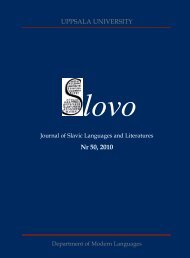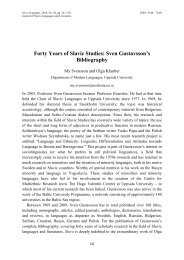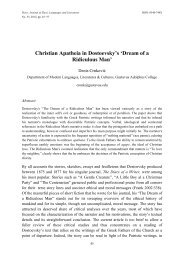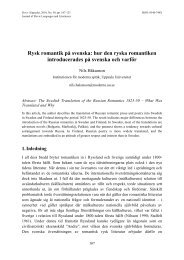Slovo (<strong>Uppsala</strong>), 2010, No. 51Journal <strong>of</strong> Slavic Languages and Literaturestime for editing (since students usually do not want to miss the entire lecture). On theother hand, if a lecturer in the same classroom is reading his or her lecture aloud froma manuscript prepared in advance, which has probably been edited several times and issubject specific, it is more difficult to determine whether the text is spoken or writtenlanguage. In other words, what are considered spoken and written modes <strong>of</strong> expressionare in essence two forms <strong>of</strong> communication in the same language, oral and graphic.The choice <strong>of</strong> one or another <strong>of</strong> these two forms <strong>of</strong> communication usually dependson the situation at hand. What motivates the structuring <strong>of</strong> the information, i.e., thesyntactic parameters, is whether the primary purpose <strong>of</strong> the communication isinterlocutor interaction or information. In the first case, information is exchangedthrough questions, discussion and argument; in the second, information is presented,through the introduction <strong>of</strong> new material, elaboration, and explanation. The choice <strong>of</strong>spoken vs. written mode is more situational, while the choice <strong>of</strong> how to structure theinformation is more stable. That is, when relating the syntax <strong>of</strong> written and spokenlanguage, the central issue is what is being compared: the spoken vs. written modes assystems, the specific styles or registers within the two modes (academic prose, fiction,journalistic prose, face-to-face conversation, telephone conversation, media speech,etc.), or different text types such as dialogue and non-dialogue? The main focus <strong>of</strong> thisstudy is whether syntactic constructions in Bulgarian are grounded in a written/spokenopposition, or in a dialogue/non-dialogue opposition. In other words, can dialogue andnon-dialogue be “fingerprinted” in syntactic terms as intermediate text types for bothspoken and written Bulgarian?Within the written mode, dialogue in fiction can be distinguished from the dialoguein a play. Both genres represent a simulation <strong>of</strong> an oral conversation presented throughone voice (the writer‟s), but they are different in respect to at least one importantfactor: while the dialogue in a play is written to be performed on a stage, in front <strong>of</strong> anaudience, the dialogue in fiction is most likely to be read by one person at a time.Moreover, the dialogue in a play aims to tell the “whole story”, while the dialogue in abook does not. A similar observation can be made about face-to-face conversation,which can be viewed as dialogue between two (or more) participants, while adiscussion in the “media space” is intended for an audience.The primary objective <strong>of</strong> a conversation is interaction by which the speech actparticipants exchange information, while a discussion in front <strong>of</strong> an audience (visibleor not) has a different purpose, in that it is intended to convey information 1 . Thus, thepurpose <strong>of</strong> these two kinds <strong>of</strong> interactions is different, as are their situationalcharacteristics. In fictional dialogue, we can expect a dialogue structure with to somedegree equal participation <strong>of</strong> the involved individuals, and with regular turn-taking.1 The use <strong>of</strong> the opposition interaction/conveyance <strong>of</strong> information is strongly associated with studies in genderlinguistics (e.g. Tannen 1994). In this article all the samples are treated as exchanges or presentation <strong>of</strong>information, where the gender aspect is not considered.116
Daniela AssenovaSpoken vs. Written or Dialogue vs. Non-Dialogue…Such synchronous dialogues are typical <strong>of</strong> face-to-face and telephone conversations,where some degree <strong>of</strong> regular interaction between speech act participants is alsoexpected. On the other hand, the dialogue structure <strong>of</strong> TV talk shows, radiodiscussions, parliamentary debates or political interviews are much moreasynchronous. In these more formal scenarios, the role <strong>of</strong> the participants is quitedifferent: there is a host or moderator who invites other participants to presentinformation. Thus, although the interaction resembles dialogue in its general structure,the exchange <strong>of</strong> turns between the involved individuals is not equal. The moderatorwill usually talk less than the others, while the participants will talk considerablylonger, i.e. there will be intervals <strong>of</strong> non-dialogue. Moreover, the information loading<strong>of</strong> the texts will be different, since the focus will be to present and elaborate theirposition.In syntactic terms, the noun (N) and the verb (V) are the core arguments, the subjectand the predicate, in a clause. Their frequency in different texts, whether spoken orwritten, can indicate how the information is structured. For morphologically analyticlanguages like Bulgarian, a prepositional phrase (PP) is relevant to both a noun phrase(NP) and a verb phrase (VP), in that it can be either a modifier within the NP or part <strong>of</strong>the valence <strong>of</strong> the verb in a VP. The frequency <strong>of</strong> nouns, verbs, and PPs in written vs.spoken texts is the primary object <strong>of</strong> this study.2. Related workAs far as the syntax <strong>of</strong> spoken and written Bulgarian is concerned, two generalpositions among Bulgarian scholars can be traced, from before and after the mid-1980‟s.The first position, which is based on literary works alone, views the structure <strong>of</strong> thewritten dialogue as similar to that <strong>of</strong> spoken Bulgarian, albeit with more ellipses in theclause and within the sentence (Popov [1961] 1998:62, 112–114). 2 According toPopov, the most commonly omitted element on the clause level is the predicate, and onthe sentence level, the main clause in the answer to a question. Such “grammaticallyincomplete” (ibid. 112) clauses and sentences are context-dependent and morefrequent in spoken Bulgarian. In “Gramatika na săvremennija bălgarski knižoven ezik”(GSBKE 1983:112) the use <strong>of</strong> “incomplete sentences” is described as frequent invarious styles, but most frequent in literature.The second position on the syntactic structure <strong>of</strong> spoken and written Bulgarian canbe viewed as a change in the focus <strong>of</strong> the research target, which is defined inAngelova‟s 1994 monograph as “description <strong>of</strong> the most characteristic syntacticconstructions in spoken Bulgarian” (6). Angelova‟s phrasing summarizes an important2 In this paper the terms “clause” and “sentence” are used as corresponding to “просто изречение” and “сложноизречение”, respectively, which are the traditional terms in Bulgarian grammar books.117
- Page 1 and 2:
UPPSALA UNIVERSITYlovoJournal of Sl
- Page 3:
CONTENTSEDITORIAL: SLOVO ARAUND THE
- Page 6 and 7:
Slovo (Uppsala), 2010, No. 51Journa
- Page 8 and 9:
Slovo (Uppsala), 2010, No. 51Journa
- Page 10 and 11:
Slovo (Uppsala), 2010, No. 51Journa
- Page 12 and 13:
Slovo (Uppsala), 2010, No. 51Journa
- Page 14 and 15:
Slovo (Uppsala), 2010, No. 51Journa
- Page 16 and 17:
Slovo (Uppsala), 2010, No. 51Journa
- Page 18 and 19:
Slovo (Uppsala), 2010, No. 51Journa
- Page 20 and 21:
Slovo (Uppsala), 2010, No. 51Journa
- Page 22 and 23:
Slovo (Uppsala), 2010, No. 51Journa
- Page 24 and 25:
Slovo (Uppsala), 2010, No. 51Journa
- Page 26 and 27:
Slovo (Uppsala), 2010, No. 51Journa
- Page 29 and 30:
Alexander I. Pereswetoff-MorathIsaa
- Page 31 and 32:
Alexander I. Pereswetoff-MorathIsaa
- Page 33 and 34:
Alexander I. Pereswetoff-MorathIsaa
- Page 35 and 36:
Slovo (Uppsala), 2010, No. 51, pp.
- Page 37 and 38:
Juhani NuorluotoIzvori za prouĉava
- Page 39 and 40:
Juhani NuorluotoIzvori za prouĉava
- Page 41 and 42:
Juhani NuorluotoIzvori za prouĉava
- Page 43 and 44:
Juhani NuorluotoIzvori za prouĉava
- Page 45 and 46:
Juhani NuorluotoIzvori za prouĉava
- Page 47 and 48:
Juhani NuorluotoIzvori za prouĉava
- Page 49 and 50:
Juhani NuorluotoIzvori za prouĉava
- Page 51 and 52:
Juhani NuorluotoIzvori za prouĉava
- Page 53:
Juhani NuorluotoIzvori za prouĉava
- Page 56 and 57:
Slovo (Uppsala), 2010, No. 51Journa
- Page 58 and 59:
Slovo (Uppsala), 2010, No. 51Journa
- Page 60 and 61:
Slovo (Uppsala), 2010, No. 51Journa
- Page 62 and 63:
Slovo (Uppsala), 2010, No. 51Journa
- Page 64 and 65:
Slovo (Uppsala), 2010, No. 51Journa
- Page 66 and 67:
Slovo (Uppsala), 2010, No. 51Journa
- Page 68 and 69: Slovo (Uppsala), 2010, No. 51Journa
- Page 71 and 72: Slovo (Uppsala), 2010, No. 51, pp.
- Page 73 and 74: Никита МихайловО м
- Page 75 and 76: Никита МихайловО м
- Page 77 and 78: Никита МихайловО м
- Page 79 and 80: Никита МихайловО м
- Page 81 and 82: Никита МихайловО м
- Page 83: Никита МихайловО м
- Page 86 and 87: Slovo (Uppsala), 2010, No. 51Journa
- Page 88 and 89: Slovo (Uppsala), 2010, No. 51Journa
- Page 90 and 91: Slovo (Uppsala), 2010, No. 51Journa
- Page 92 and 93: Slovo (Uppsala), 2010, No. 51Journa
- Page 94 and 95: Slovo (Uppsala), 2010, No. 51Journa
- Page 97 and 98: Slovo (Uppsala), 2010, No. 51, pp.
- Page 99 and 100: Карине Окерман Сар
- Page 101 and 102: Карине Окерман Сар
- Page 103 and 104: Карине Окерман Сар
- Page 105 and 106: Карине Окерман Сар
- Page 107 and 108: Карине Окерман Сар
- Page 109 and 110: Slovo (Uppsala), 2010, No. 51, pp.
- Page 111 and 112: P. Ambrosiani, A. GranbergSlavonica
- Page 113 and 114: P. Ambrosiani, A. GranbergSlavonica
- Page 115: Stockholm, The Strindberg Museum (S
- Page 120 and 121: Slovo (Uppsala), 2010, No. 51Journa
- Page 122 and 123: Slovo (Uppsala), 2010, No. 51Journa
- Page 124 and 125: Slovo (Uppsala), 2010, No. 51Journa
- Page 126 and 127: Slovo (Uppsala), 2010, No. 51Journa
- Page 128 and 129: Slovo (Uppsala), 2010, No. 51Journa
- Page 131 and 132: Slovo (Uppsala), 2010, No. 51, pp.
- Page 133 and 134: Мария ЭнгстремАпоф
- Page 135 and 136: Мария ЭнгстремАпоф
- Page 137 and 138: Мария ЭнгстремАпоф
- Page 139 and 140: Мария ЭнгстремАпоф
- Page 141 and 142: Мария ЭнгстремАпоф
- Page 143 and 144: Slovo (Uppsala), 2010, No. 51, pp.
- Page 145 and 146: Ingrid MaierRecension: Tore Nesset:
- Page 147 and 148: Ingrid MaierRecension: Tore Nesset:
- Page 149 and 150: Ingrid MaierRecension: Tore Nesset:
- Page 151: Slovo (Uppsala), 2010, No. 51, pp.












